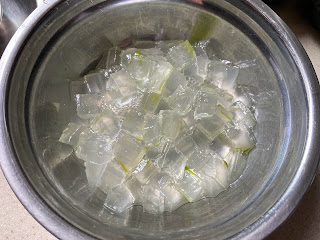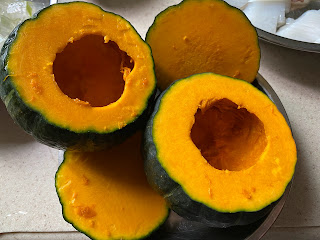This sushi restaurant is located on 18/F Aura on Pennington, with its name meaning ‘to be delighted’ in Japanese. Arriving sharp at our booking time, we were the first couple in the restaurant, and were seated at the middle of the C-shaped sushi counter, served by Chef Yip for the evening.
With large windows on the background looking out to the busy Causeway Bay skyline, there are four chefs busy preparing the food. The whole décor and setting are the familiar, decent sushiya environment, comfortable but not particularly impressive.
I order the Kyoku Omakase Set ($2,280 each), as well as a bottle of Hakurakusei Junmai Daiginjo 伯楽星 純米大吟醸 ($880) from Niizawa Brewery in Miyagi, which is a versatile sake able to pair well with the different food on the menu.
The first course is the appetizer, comprising of Mozuku 水雲, Isotsubugai 磯粒貝, and Chawanmushi 茶碗蒸. The sea moss has been marinated in vinegar with a refreshing acidity to stimulate the appetite, while the small whelk has delicate sweetness and a good bite. The steamed egg custard has Sakura shrimps and crab meat added, with nice umami taste, while the egg is silky smooth in texture.
The second course is Sirasu-Unagi 白子鰻. The baby sea eel is transparent in colour, with a wonderful texture reminiscent a bit of rice noodle. Added with some yuzu juice and menegi, it is another appetizing starter with pleasant acidity to start the meal.
The third course is Hotaru-Ika 蛍烏賊. The raw firefly squids have been marinated well, sweet and with intense flavours. There are some yuzu shavings added, with the touch of yuzu fragrance enhancing the overall enjoyment.
Coming to the sushi, the first piece is Ishigakidai 石垣鯛. The spotted knifejaw has a nice, firm bite with delicate sweetness and a rich taste. I also like the shari being quite airy, with the right level of temperature and acidity. Very nice piece.
Next is the Kobashira 小柱. These are the abductor muscles of the round clam, with the chef using a skewer to grill a number of them on charcoal, infusing with a hint of smokiness while not making them dry. In fact, I like this more than the larger-sized scallops.
Coming back to the sushi, the second piece is Aoyagi 青柳貝. The chef first torched the engawa of the round clam, before adding to its meat and make the sushi, increasing complexity in texture and flavours, on top of the already sweet and umami taste of the clam. Another nice piece.
Switching back to the sashimi, this time it is the sea urchin trio. One is the fresh Bafun-Uni 馬糞雲丹 in salt water, very soft and with a milder, more delicate taste. The next is Shiro-Uni 白雲丹, with the chef pairing with some seaweed salt, which highlight its sweetness and is my favourite among the three. The last is Bafun-Uni with Ikura 筋子 and Junsai 莼菜, with the salmon roes marinated in-house, with a lighter saltiness, and the watershield giving a complementary crunchy texture.
Returning to sushi, the third piece is Kinmedai 金目鯛, and the chef has torched the skin briefly to revitalize the fish oil. The aged splendid alfonso has a tender texture, rich in flavours and umami, with a touch of rock salt to season to good effect.
As my wife did not want raw oyster, the chef has replaced it with Shirako 白子. The grilled sea bream milt is served two ways, one from the original taste, just with a touch of salt to season; the other is a novelty, paired with Pakistan curry, with the spicy fragrance matching surprisingly well. A good example of how the chef has challenged the status quo to bring new ideas into traditional cuisine.
Coming to the fourth piece of sushi, it is the seasonal Kasugo 春子鯛. The young sea bream has a leaner flesh, with the chef having marinated it in vinegar briefly to give a bit of sour note but without drying it out. Together with some yuzu shavings, the complex flavours are appealing.
The twelve course is another seasonal item, Komochi Yari-Ika 子持槍烏賊. The pregnant spear squid is filled with its own eggs, having soft and creamy mouthfeel. The sauce is delicious as well, imparting flavours to the squid, and the touch of yuzu shavings and the sansho leaf helps to freshen and gives a hint of spice.
The chef prepares a variety of ways to enjoy the seasonal wild Hotategai 帆立貝. The first way is to serve raw, with the scallop sweet in taste and soft on texture. The second way is to slow cook, with a firmer texture and adding a bit of salt to season. The third way is to dip the liver into sesame oil. All of them good in taste and having a sweeter taste than those farmed ones.
Another prized dish comes next, the Kyushu Awabi 鮑. Steamed perfectly, the abalone has a nice tenderness, not rubbery at all, paired with a rich and creamy sauce made from its liver. Quite nice, but I cannot avoid comparing it with another famous sushiya in Central with their signature, and apparently this is not at that same level.
Returning to the sushi, it is the trio of Maguro 鮪, with the first serving Akami Zuke 赤身. The lean tuna has been briefly marinated in soy sauce, imparting the flesh with additional umami and flavours, while retaining a soft texture. Very good indeed.
The second of the trio is Chu-Toro 中とろ, with the tuna aged for 12 days. The medium fatty tuna has a rich taste, very delicious and flavourful, with soft texture. My favourite among the three cuts, and one I would encore as well, if not for the other additional pieces Chef Yip has kindly served me later.
The third of the trio is apparently, the most prized O-Toro 大とろ. Of the same fish and having aged for the same 12 days, the fatty tuna has an even stronger, more flavourful taste. But the issue for me is that unavoidably there are also more tendon. Despite the chef skilfully removing most, there are still some little fiberous part requiring a bit of chewing.
As a transition we are served Hotaru-Ika 蛍烏賊 again, but this time the chef has used the same seasonal firefly squid to make tempura. The batter is thin but in my opinion a bit oily, and there is a piece of Nanohana 菜の花 on the side, with a sprinkle of karasumi to give extra umami taste.
To freshen up the palate after tempura, we are provided Tomato with Junsai 莼菜. The watershield comes from Okinawa and has the vinegar added to give nice acidity, while the tomato has a nice balance of sweet and sourness, with a bit of whitebait and chopped shiso leaf to complement.
By now we have finished 19 courses, and the next is Buri 鰤 Sushi, with the matured yellowtail smoked to infuse with nice fragrance, with the intense flavours also very delicious.
Another prized fish, the Nodoguro 喉黒 is a deep-sea delicacy, with the Blackthroat Seaperch heavy in fish oil, and so after torching it the fragrance is memorable, and the taste is also irresistible.
Earlier in the meal I have seen the chef removing the meat from the Kegani 毛蟹, wondering how it is served. The chef put the crab meat on top of some shari, then place some Awaji sea urchin on top. The creamy and rich-flavoured sea urchin and delicate crab meat is nicely complementary in taste.
Then it is Anago 穴子. Brushed with a good kabayaki sauce, the conger eel is nicely braised, very soft in texture, to the point of essentially melting in the mouth.
The Kuruma-Ebi 車海老 has also an interesting twist. After removing the shell and innards, flattening it to make the sushi, the chef has prepared the hepatopancreas into a condiment paste to put on top of the tiger prawn, enriching the flavours and additional seasoning to the sweet taste.
Another innovative course comes next, with the chef spreading a paste made from Ankimo 鮟肝 and some finely chopped Narazuke 奈良漬 on a piece of crispy rice cracker, made from the same rice as the shari. A creative way to present this dish which gives contrast in texture. Very nice.
Then it is the Saba-Maki 鯖巻. The mackerel has been marinated in vinegar in the traditional style, and then made into the roll, with a piece of pickled kombu on top. A fulfilling course to wrap up the meal.
The chef then introduced the Tamagoyaki 玉子焼, claiming to be among the top three in town. It is really good indeed, with the fluffy texture pleasant, the crust having a nice caramel from the brown sugar, while balancing with the umami of the egg mixture. No wonder he is so proud of this course.
Even though quite full, I cannot resist the temptation to order a few extra pieces. First is Kohada 小鰭, with the silvery gizzard shad sufficiently marinated to give a nice sourness note but also retaining its unique flavours of which I enjoy.
The other additional piece is Aji 鯵. The Japanese horse mackerel comes from Nagasaki, very fresh and with rich and intense flavours. I am curious why it is not offered in the beginning. But I certainly would not complain as I can it enjoy now.
The Miso Soup is prepared using red miso, appropriate in the saltiness for us. There are some okra to give a bit of bite and texture, with the clams providing the umami to the soup, warming our stomachs for a happy evening.
The dessert is Strawberry Pudding. The strawberry, being in season, is very sweet, while the pudding is decent and completes the whole meal with a highly satisfactory note.
Service is good, with the chef friendly and eager to share with us the seasonal ingredients and their specialties. In terms of portion and variety, it has one of the widest offerings in town. The cost on the night is $5,984 and considering the overall experience and quality, a good value in my opinion. But seeing how quiet the restaurant was, I can feel the difficulty the industry is facing.

























































